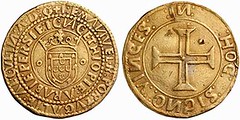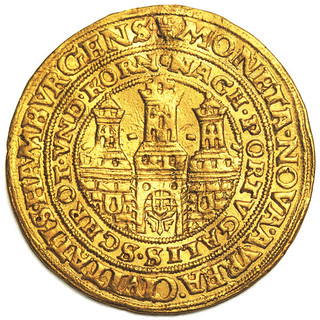
PREV ARTICLE
NEXT ARTICLE
FULL ISSUE
PREV FULL ISSUE
VOCABULARY WORDS: PORTUGALÖSER AND PORTUGUEZLast week Tom Wetter asked: What is a Portugalozer? Google is stumped. Thomas Elder has one catalogued in his November 1934 sale. His exact listing is "PORTUGALOZER OF JOHN III".
Boy, did he come to the right place!
Gar Travis, Paul Cartmill, John Mutch and several others responded.
Here's what some of them had to say.
-Editor
First to respond was Ron Guth, who writes:
A Portugaloser is a generic term for a 10 ducat gold coin. Here's a link to a 1991 article in the Numismatist about the Portugueses and their "Portugaloser" derivatives:
Portuguese Coins in the Age of Discovery
(www.conteudos.easysite.com.pt/files/48/ficheiros/historia_monetaria/ Tom DeLorey writes: I would hazard a guess that the "Portugalozer" catalogued by Tom Elder was a "Portugal Cruzado," which John III did issue. Ken Spindler of San Diego, CA writes: I trust you will receive more informative and authoritative responses, but I've heard the term before and see that a Portugalöser was another name for a gold 10-ducat trade coin issued at least by German states and Denmark in the 17th Century. I have the impression the name alluded to acceptability (meeting a specific standard) for international trade, apparently in Portuguese colonies. This is certainly subject to correction! Eric Vanhove writes:
I was challenged! I found a link to a book in Google Books which is a Dutch dictionary/encyclopedia from 1777. Here's the original and a very rough translation from the ever-useful Google Translate:
Stater. Tetrodrachmus. Eene Grieksche en Hebreeuwsche Munt, vanwelke ook in de Schriften van het Nieuwe Testament gewag gemaakt wordt. Een van Zilver woog gemeenelyk een Loot en deed 12 Grosschen. Die van Goud, zynde in het Joodsche Land niet gemunt, wierd naar den Konig genaamd. weens Beeld daarop stond. Dus had men, by voorbeeld: Darici, Philippici en Alexandrici, en sommigen waren zoo groot als de portugalozer. Anderen woogen 2,3, 4 of meer Ducaten. .... Google Translate (plus me for a little context): Stater. Tetrodrachm. A Greek or Hebrew coin mentioned in the scriptures of the New Testament. One of silver weighed roughly the weight of 12 Groschen. Those of gold were not minted in Jewish lands, were minted in the name of the king, whose image on it appeared. There were, for example, Darici, Philippici, and Alexandrici (Darius, Philippus, and Alexander?), some were as large as the PORTUGALOZER. Others weighed 2, 3 4 or more ducats. No, there is no entry in the dictionary for Portugalozer. There is a Portuguese king John III (ruled 1521-1557) To access the Google Books item, see: Jim Duncan quotes Ewald Junge from his "World Coin Dictionary" (p203): PORTUGALÖSER A large gold coin based on the portuguez and struck to the value of 10 ducats in a number of German cities, usually for commemorative purposes. The most extensive is that struck in Hamburg from 1553-1673. There is another Hamburg series, dating from the foundation of the city bank in 1667 until the mid-19th century, but these "Bankportugalöser", as they are called, are more properly classed as medals. PORTUGUEZ A large Portuguese gold coin, to the value of 10 cruzados, struck from 1499-1557. It commemorated in its legend Portuguese discoveries, conquests and trade. Henry Goodman writes: The Portugalöser is a piece originally struck in gold of the value of 10 Ducats, which circulated as a coin, but served chiefly as a complimentary presentation at weddings, births, and similar occasions. From the sixteenth century the Portugalöser has been struck in Hamburg. The name was derived from the large Portuguese crusados which were current in Germany among other foreign coins at that time. Since the state reserved itself the exclusive right of issuing coins, the banks in Hamburg issued Portugalöser in gold and silver, but rather in the style of medals featuring city views and shipping ports. Bank Portugalöser's were also used as bullion minted at precise weights in order to assist banking transfers between Hanseatic League city states of the time. More info can be found in the Davenport suite of Taler volumes as well as in the "Use of God's Name; Jehovah on Coins, Medals, Tokens, and Jetons" by Saul Needleman. Ursula Kampmann writes: I know all your readers will know what a Portugalese is - here the historical background, why it developed.
I should have guessed this was already covered elsewhere. It was Elder's spelling of the term that fooled Google. Here's a short excerpt from the article Ursula pointed to, one she authored for Coins Weekly. Thanks!
-Editor
 Emmanuel I (1495-1521). Português of 10 Cruzados n. d., Lisbon.
Emmanuel I (1495-1521). Português of 10 Cruzados n. d., Lisbon.
At the end of the 15th / beginning of the 16th century, today’s capital of Portugal, Lisbon, acquired a favoured position in the gold trade as a popular interstation. Italian merchants from Genoa or Venice bought gold in the Arab Maghreb that had been transported from the Sudan via the Sahara desert to the Mediterranean coastal towns. They paid with silver, only six times the gold weight. In the North, however, the gold was counterbalanced ten times the value of silver. What was easier than to travel the Atlantic route to the big commercial towns at the North Sea to sell the gold for plenty of money? The most important reloading point became Portugal where the Arab money was recoined into Portuguese coins. These imposing gold coins worth 10 Cruzados were called Português. Their predecessors go back to 1340. In those days, tradesmen claimed that these Portuguese gold coins weighed as much as “100 Moroccan Doubloons”. Under John II of Castile (1406-1454), these pieces grew to an enormous size; they were produced in weights up to 235 grams. Coins that big were of course never intended to serve as currency in everyday transactions. Basically, they were ingots in the shape of coins whose weight and purity were guaranteed by the national die and hence were easier to trade on the market. In the Northern cities these coin ingots were recoined into local currency or saved as an investment of stable value and hoarded for the case of need. Portuguese large gold coins were very popular in the rich commercial cities in Northern Europe. To read the complete article, see: Gold for Portugal (www.coinsweekly.com/en/Gold-for-Portugal/8?&id=69&type=a) Dave Alexander writes: Portugaloeser were large and quasi-medallic gold pieces first struck by the Bank of Hamburg (Free and Hasseatic City of Hamburg in North Germany) for commemorative purposes. There were a variety of later issues. The term derives from the Portuguese gold 3,900 Reis, later increased to 4,000 Reis by King Manoel I (1495-1521) with later issues in the name of King Joao (John) III in 1521-1557. The coin's majestic size and weight made it an impressive vehicle for commemorative purposes. Bruce W. Smith explains the different spellings. He writes: It is usually spelled Portugaloser. It's actually a Portuguese gold coin, in this case issued by John III (ruled 1521-1557), which was actually called a Portuguez. The term Portugaloser refers to pieces of similar weight or size issued in parts of Germany, Transylvania, Poland and elsewhere, with a value of 10 ducats or 10 kronen. According to Frey's Dictionary of Numismatic Names (1917), these north European pieces were actually struck for presentation, not circulation. Bruce also found this entry on the "Portugaleser", yet another spelling variant: The name of this coin is German, and refers to Portuguese coins that made their way northward, such as this heavy gold coin worth ten cruzados, introduced in 1499 by Manuel I. It reflects the riches, above all in the form of gold from Africa, that flowed to Portugal as a colonial power. And its inscription is confident: "in hoc signo vinces" (in this sign [the cross] you will conquer). This impressive coin, which was well suited to being a present, was soon imitated in the north of Germany and Northern Europe. In Hamburg, where most of these "expatriate Portuguese" coins were minted, the name «Portugaleser» survives as a term for gold medals awarded for special purposes.

To read the complete article, see: Portugaleser (www.moneymuseum.com/moneymuseum/library/pictures/image.jsp?lang=en&ix=19&i=23) Ralf Böpple writes: "Portugalozer" is a misspelling of a coin from northern Germany called "Portugalöser" or "Portugaleser", which is an imitation of a gold coin that was issued in Portugal in the early 16th century. The main mint for the production of these numismatic items, which served as trade coins in the Baltic region, was Hamburg. Still today "Portugalöser" are issued there by the city council in the form of medals of honor. The original listing seems to have been for a coin of John III (Joao in Portuguese), which would be the Portuguese king under which reign the first coin of this type was struck. So it's actually not the northern German imitation, but the Portuguese original, and as such a misnomer in the catalog ("portuguez" or "10 cruzados" would have been the right denomination). Ron Haller-Williams writes: PORTUGALOZER is one of the many spelling variants (such as podogloser, portugaleser) for PORTUGALOSER. PORTUGALOSER: a 10-ducat gold coin (hence weight approx. 34.9 grams) of such places as Danzig, L=FCbeck, Magdeburg & Hamburg (North Germany) and Deventer, Zwolle (Netherlands), based on the gold Portuguez (10 cruzados) of Manuel I of Portugal (1495-1521), which was first struck c1499. These "Portugalosers" were produced from c1550 until well into the eighteenth century, though the later ones (after 1693?) were more for commemorative or gift purposes than for circulation. Note: There are many replicas of these coins, which are mostly very rare. I hope this helps. The form PORTUGALOSER should be much easier to find, including in Friedberg. Henk Groenendijk writes: The obverse of a Portugalozer of Manuel I is depicted on a Portuguese commemorative coin of 1000 Escudos of 1983 (KM622). An interesting booklet about the Portugalozer was issued in Lisbon in 1983. The Author is Antonio Miguel Trigueiros. The title is Moeda dos descobrimentos prestigio de Portugal no Mundo. In this book the original Portugalozer and several contemporary copies are illustrated. Places of issue were: Hamburg, Magdenburg, Luneburg and Lubec in Germany. Denmark, and Zwolle and Deventer in the Netherlands.
Wow! With each new email I learned a little more about these coins. Thanks!
-Editor
To read the earlier E-Sylum article, see:
QUERY: WHAT IS A PORTUGALOZER?
(www.coinbooks.org/esylum_v15n39a20.html)
The Numismatic Bibliomania Society is a non-profit organization promoting numismatic literature. See our web site at coinbooks.org. To submit items for publication in The E-Sylum, write to the Editor at this address: whomren@gmail.com To subscribe go to: https://my.binhost.com/lists/listinfo/esylum All Rights Reserved. NBS Home Page Contact the NBS webmaster 
|